 |
The Gibson Guitars of Scotty Moore
This article was initially
published in a UK publication "Elvis-The man and his music" in
the mid 90s. A copy was given to Scotty
who then forwarded a copy to me and used here with the approval of its
author, Jan-Erik Kjeseth. Some details I've
found to be not exact and I'll note where I can but for the most part
wanted it to appear as written. The pictures were also not in the
original article but I've included them here for visual reinforcement.
James V. Roy
by Jan-Erik Kjeseth
The majority of
the major guitar players associated with Elvis were Gibson oriented.
To name a few: Hank Garland,
Tiny Timbrell, Grady Martin, Barney Kessell and, of course, Scotty
Moore.
In the case of Scotty, let’s first take the short route.
Here’s what he told BBC reporters John Tobler and Stuart Grundy
in 1983: “When I came out of the service I bought one of those Fenders,
a Telecaster or Stratocaster or something, but I couldn’t hold on to the
thing with its little slim body. It
might have something to do with it being a feminine shape, but I
couldn’t get on with the Fender.
So I got a Gibson, a gold ES
295, and that was the one I used on the first things we cut.
Then I went on to the L5, and I had a blonde one of those.
From there I went to a blonde Gibson Super
400, which is here in town, by the way.
We had a big instruments trading thing in
Memphis
one time, trading vibes and guitars and all sorts of things.
Chips Moman ended up with the Super 400, and I’ve always wanted a
Sunburst 400, and that’s the
one I’ve still got. I’ve
always been partial to the sound of the big body guitars, although people
today still say they get problems with feedback and so on.
There were problems until they made feedback work for them, I
should say. I never used a
solid guitar, and I’ve never used small gauge strings – I just bled a
lot!”
To make sure this article was as accurate as possible; we faxed a draft
copy to Scotty in
Nashville
. Very enthusiastic about it,
he sent a return fax full of interesting and relevant comments that we
were able to incorporate into the piece.
For example, Scotty now recalls that his first guitar was a Fender
Esquire (actually a Telecaster), and he had a very small Champ (actually a Fender
Deluxe) amp to go with it.
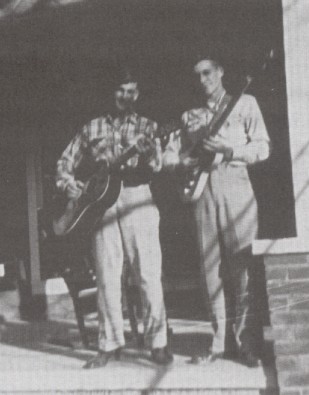
(friend) James Lewis and Scotty with his Fender Telecaster
(1953)
Photo © Scotty Moore
Regarding the
comment he made above about the instrument exchange in
Memphis
, only Scotty and Chips were involved.
The blonde Super 400 was exchanged for a few things Scotty needed
for Sam Phillips’ studio, where Scotty was at that time the manager.
VARIOUS
MODELS
Let’s take a somewhat closer look at the various models used by
Scotty over the years. On the
first Sun recordings he used the famous ES 295.
I guess the fact that Scotty Moore used it made it famous. The
only other famous guitarist that I know of who sometimes used the ES 295
was Danny Gatton, who passed away in October 1994.
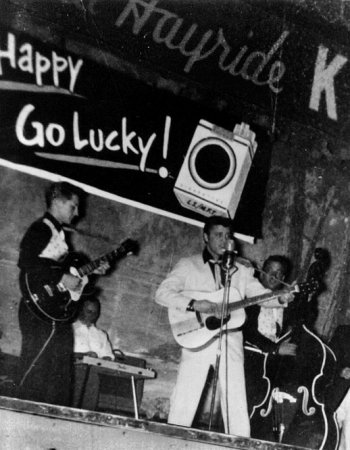
Scotty with ES 295 and Elvis with Martin D18 (1955)
Photo© courtesy of Louisiana
Hayride Archives - J. Kent
The ES (Electric Spanish) 295 (as well as the other Gibson guitars that
Scotty used), belongs to the family of cello-bodied, semi acoustic jazz
guitars that helped so much in building Gibson’s reputation in the world
of guitar manufacturers. All
of this stems from 1924, really, when Lloyd Loar designed and put into
production the first Gibson F-hole guitar, the L5 acoustic (there are
photos of Elvis playing Tiny Timbrell’s L5 on the set of ‘Loving
You’ ).
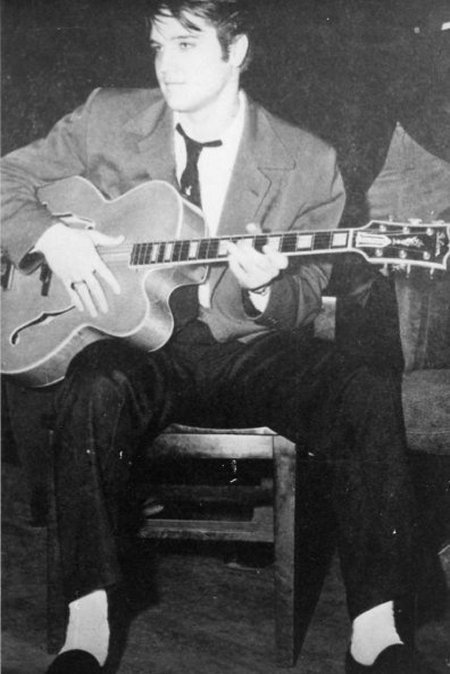
Elvis playing Tiny Timbell's L-5 P
Photo courtesy Jan-Erik Kjeseth
The L5 went
electric in 1951,
when the first L5 CES (Cutaway Electric Spanish) was produced.
The big-bodied, semi acoustic jazz style guitar has more or less been the
flagship of the Gibson range. The
finest woods, materials and workmanship have always been lavished on these
instruments. The
semi-acoustic tone is obtained from the interior of the guitar, which is
hollow. Jazz and blues
guitarists tend to favor the ‘woody’ tone of a semi-acoustic to the
bite and volume associated with a solid body guitar.
As mentioned earlier, Scotty used an ES 295 on the first Sun recordings
– ‘That’s All Right’, ‘Good Rockin’ Tonight’ etc.
Gibson only built 1770 of this model, so today an ES 295 is rare
indeed.
Produced from 1951 to 1965 (1952 to 1959), the
ES 295 had the same shape and dimensions as the ES 175, but was equipped
with two cream single coil pickups as well as a Les Paul type combination
trapeze-bridge assembly. The
finish was in matt gold and the single cutaway was of the sharp
(Florentine) type. Brian
Setzer of The Stray Cats has referred to the ES 295 as “the ultimate
rockabilly guitar”. Scotty
himself, however, went on to the L5
CES and he once commented “it was probably the better guitar for our
kind of music”.
Scotty says he made the transition from the ES 295 to the L5 CES in time
for the Sun session that produced ‘Mystery Train’.
It was on that session that he also used the Ray
Butts EchoSonic amp for the first time too.
More on that later.

Scotty with his 54 L5 CESN
This particular version of the L5 CES was of the blonde, rounded
(Venetian) single cutaway variety. Scotty
played this guitar on some of the final Sun recordings as well as
‘Heartbreak Hotel’, ‘Blue Suede Shoes’, ‘Lawdy Miss Clawdy’,
‘Hound Dog’, ‘Don’t Be Cruel’, ‘Any Way You Want Me (That’s
How I will Be)’ and ‘Mean Woman Blues’, to name but a few.
Elvis borrowed the very same L5 CES during a break in the
proceedings when they were trying to cut ‘One Night’, but couldn’t
get it quite together until he got hold of an electrified guitar!
JAILHOUSE
ROCK
By the time they reported to
MGM for the ‘Jailhouse Rock’ sessions, Scotty had traded in the L5 CES
for a blonde, single rounded cutaway Super 400 CES.
Production on the Super 400 started in the mid-30s.
It ‘went electric’ in 1951 and thus became the CES (Cutaway
Electric Spanish). All models
up until 1958 were equipped with two square pole Alnico
pickups (In 1951 they came equipped with P90 pickups and Alnico V's in 54).
Humbuckers were added in 1958.
The Super 400s are readily identifiable by several features: the large
peghead, split-diamond peg-head inlay, squared bell truss rod cover, split
block markers and a unique tailpiece.
Scotty used the blonde Super 400 CES on ‘Jailhouse Rock’, ‘King
Creole’ and the first post-Army sessions.
He was still using it when he accompanied Elvis on stage in
Hawaii
in 1961. What makes an
interesting postscript to this particular guitar is that it ended up in
the possession of Chips Moman and was hanging on the wall of the American
Sound studio when Elvis went there to record in 1969.
Reggie Young rose magnificently to the occasion.
He put aside his own 1953 Telecaster and took the Super 400 CES off
the hook. And the magic worked
again.
Soundwise the Super 400 CES is as good as any.
In addition, I’m sure the cosmetic factor appealed to Scotty.
In particular, the Sunburst model was a feast to the eye.
When Scotty recorded the album ‘The Guitar That Changed The
World’ in 1964 he had obtained the sharp (Florentine) single cutaway
Sunburst Super 400 CES that we all know so well from the 1968 NBC TV
special.
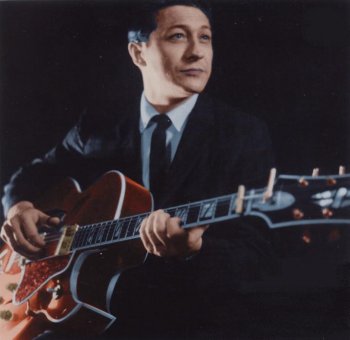
Scotty with 63 Super 400 from "The Guitar That Changed
The World"
During the two
‘sit-down’ sessions, Elvis handed over his own acoustic J 200 Gibson
to Scotty, and in return was allowed to play ‘Baby, What You Want Me To
Do’ (and others) to his hearts content on the very handsome Sunburst
Super 400 CES. It was ‘One
Night’ revisited. It was
televisions finest hour.
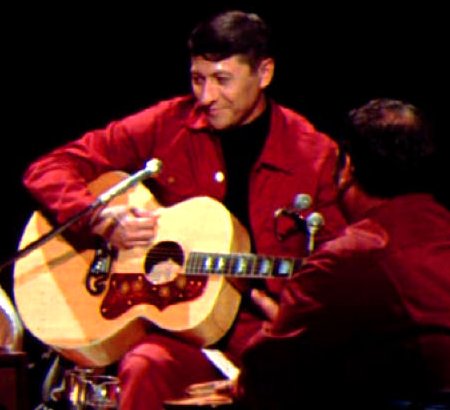
Scotty with Elvis' 1960 J200
CHET ATKINS
When the BBC visited Scotty in
Nashville
in 1983, the Sunburst Super 400 CES was still in his possession.
These days, however, he’s using a more thin-bodied Gibson – a
Chet Atkins model that was a gift from Chet himself.
Gail Pollock, Scotty’s secretary, told us “When Chet and Mark
Knopfler were doing their album together in Nashville, they came to Scotty’s office. It
seems that Mark wanted to meet the old man.
During the course of the visit, Chet commented on an old RCA 77DX
microphone that was sitting on Scotty’s desk, mounted as a paperweight.
He said that he would love to have it, and Scotty gave it to him.
Chet had some work done on it and now uses it in his personal
studio. A couple of months
later, Chet came back to the office looking for Scotty, but he was out.
Chet said, ‘Give him this – its for the microphone’, and he
handed over a beautiful Chet
Atkins Gibson. It had been
one of Chet’s personal guitars because it had the Bixby attachment.
Scotty had that taken off, he’s never used one, and a new
tailpiece added. He has been
using it onstage since then. It’s
a beautiful guitar, has a great sound and he loves it.”
These days Scotty Moore is looked upon as being one of the most
influential rock guitarists of all time – and rightly so too.
The solos he played on those classic early Elvis records will
always stand the test of time, and one of the major contributing factors
to the famed ‘Scotty Moore sound’ was the now-famous amplifier he
used. Built by Ray
Butts from
Illinois, Scotty obtained one of his EchoSonic amps
after hearing Chet Atkins using one. As
he told Tobler and Grundy for the BBC: “Boy, I can tell you that when I
first plugged in and turned that thing on I said, ‘That’s it!’.”
Scotty still has the amplifier and its still in working condition, but he
no longer travels with it. Ray
Butts is retired now and lives near
Nashville
but still insists on looking after the amp as if, as Gail told us, “it
was his own child. He gets mad
at Scotty if anyone else is allowed to open the back of it.!”
ELVIS
Finally, then, Elvis.
During the early years – 1953 – 1956 – he played a Martin
acoustic, a D18 if my information is correct (a
000-18 purchased in late summer or early fall of 54,
a
1942 D18 purchased in January of 1955 and then a
D28 by June 55).
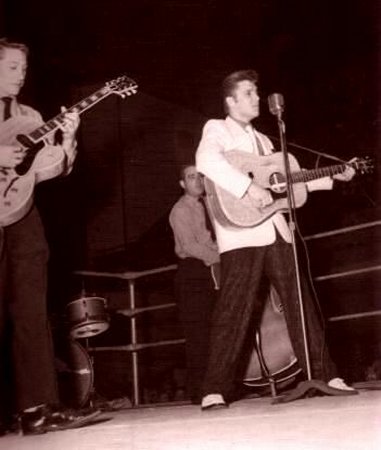
Scotty with his L5 and Elvis with his D28
The acoustic guitar basically appears in one of two forms: either an
arch-top F-hole version, or a flat-top round hole version.
The arch-top rhythm guitar is mainly a big band-type of instrument.
Players such as Tiny Timbrell, Harold Bradley or Ray Edenton might
favor the arch-top. Elvis,
however, always used the flat-top, whether he used Martin or Gibson.
In January 1957, Elvis was introduced to guitarist Tiny Timbrell.
Timbrell was also a representative of the Gibson company.
He handed Elvis a round-shouldered, big flat-top.
It was the Gibson J200 in natural finish, and Elvis loved it (Elvis actually
switched to a J200 in October
56).
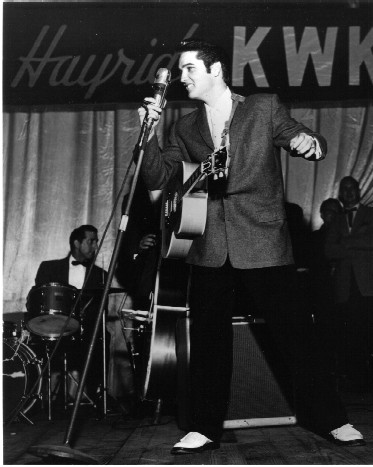
Elvis with J200 at the Louisiana Hayride December 1956
Photo courtesy Langston McEachern©
A very handsome as well as sturdy instrument, it was perfect for
both onstage and movie performances. It
was designed in 1936 and continues to be one of the best-selling items of
the Gibson flat-top catalogue.
I asked Timbrell if the fact that Elvis used it helped popularize this
particular model. “Of course
it helped!”, he replied.
Scotty’s secretary, Gail, offers some further bits of extra news on the
subject of Elvis, Scotty, Tiny and the J200: “Actually, Scotty and Tiny
became close friends working on the track sessions.
Tiny could read music and Scotty used the Nashville
number system, so Tiny helped transfer the scores over before the actual
recording sessions. Tiny was
the West Coast representative for Gibson and he signed Scotty to his Gibson endorsement agreement.
Colonel Parker would not allow Elvis to endorse Gibson, so Scotty
arranged to get Elvis’ guitar from Gibson through his endorsement.
He still has the paperwork showing the J200 with ‘Elvis
Presley’ on the neck was invoiced to Scotty Moore, not Elvis Presley.”
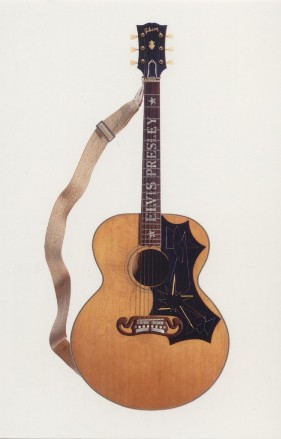
Elvis' 56 J200 as it appears today
Photo courtesy EPE, Inc©
Although, for some reason, Elvis would be seen with a Martin or a Fender
in some of the MGM movies, the J200 was his guitar right up until around
1975. He used the J200 in
‘Loving You’, ‘King Creole’, ‘G.I. Blues’ and ‘Tickle Me’.
More importantly he used it in some of the scenes in the 1968 TV
special, on stage in Memphis
in 1961 and in Vegas between 1969 – 1972.
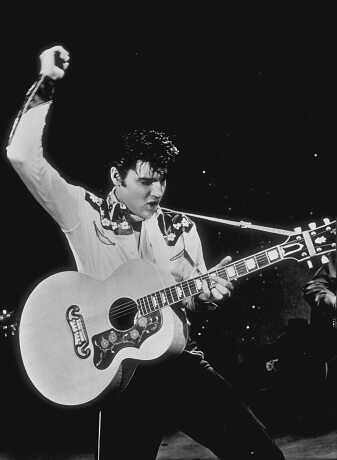
Elvis with the J200 from 'Loving You' 1957
Photo by MPTV - Image courtesy MPTV.net
Even more importantly, he used it on his recording sessions.
He played the J200 on ‘Blue Christmas’, ‘Reconsider Baby’,
‘Blue Suede Shoes’ (1960), ‘Judy’, ‘Your Time Hasn’t Come Yet
Baby’, ‘Stranger In My Own Home Town’, ‘Little Cabin On The
Hill’, ‘It Ain’t No Big Thing (But It’s Growing)’ and several
others.
SIGNATURE
MODEL
These days the Gibson company is honoring Elvis with a signature
model of the J200. Two
prototypes have been made, both hand built and designed by Gibson’s top
craftsman, Ren Ferguson.
Photos I’ve seen of Elvis on stage in Lubbock
on
November 8th 1972
show him using another Gibson flat-top, the new
Dove Jumbo.
The Dove acoustic had a square-shouldered dreadnaught body shape.
(Not quite as handsome as the J200, in my book.)
By 1975 the J200 was back, only this time Elvis used a
black model.
(It’s pictured on the front of W.A. Harbison’s ‘An Illustrated
Biography’.)
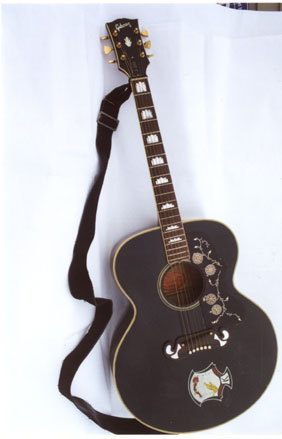
Elvis' Black J200
Another Gibson
he owned was a 1968 Southern Jumbo (SJ) which he primarily used at home
but which he also occasionally used on stage.
A recent magazine article on this guitar described it thus: “the
sound quality and finish on this mystical SJ hummer remain excellent,
although there are a couple of nicks on its face.
These can probably be attributed to Elvis’ well-known stage
antics of haphazardly tossing the guitar to Charlie Hodge, and watching
him scramble to make the catch.”
For the most part, though, Elvis seemed to prefer a Martin D-28 blonde
acoustic guitar on stage during the last few years of his life, and indeed
it was this instrument he played at his final concert in
Indianapolis
on
June 26th 1977
.
ELECTRIC
GUITARS
Elvis hardly ever used electric guitars on stage or in the recording
studio. He borrowed Scotty’s
L5 CES for ‘One Night’, and Bill Black’s
Fender Precision electric
bass for ‘Baby I Don’t Care’. On
stage in Vegas in 1969 he sometimes use a thin-bodied, double cutaway,
semi-acoustic Gretsch guitar for numbers including ‘Are You Lonesome
Tonight?’, ‘Baby, what You Want Me To Do’ and ‘Reconsider Baby’.
Photos also exist of him playing this guitar on stage in 1970.
In some scenes of the ’68 TV special, Elvis was sporting a flashy,
cherry-red, thin-bodied electric guitar which was loaned to him by
guitarist Al Casey. This
particular instrument was a Hagstrom V-2 with four black bass and treble
knobs, white pickup selector switch, dual pickup, trapeze bar and dual
F-holes.
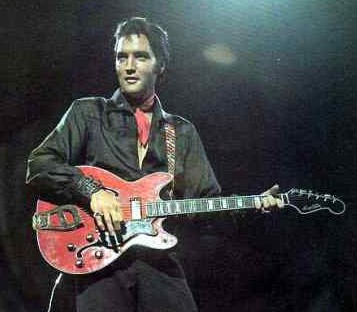
Elvis with Hagstrom Viking II
In some of the movies, such as ‘Girl Happy’ and ‘
Speedway
’, he was seen handling Fender electric guitars.
In ‘
Speedway
’, for instance he played a Fender Coronado.
In ‘Spinout’ he used a Gibson twin-neck.
None of it was for real, though – hell, he’s even shown playing
lead guitar on a Fender bass in ‘Easy Come, Easy Go’!
This was the film industry’s image of a rock star.

Elvis' remaining collection at Graceland
Photo courtesy EPE, Inc©
The real Elvis kicked off ‘Reconsider Baby’ on a J200, and to his
right were sidemen Scotty Moore on Super 400 CES and Hank Garland on a
Danelectro six-string bass. Such
moments were among the best of the century.
For more detailed info on the complete performance
guitars of Elvis Presley click here |














